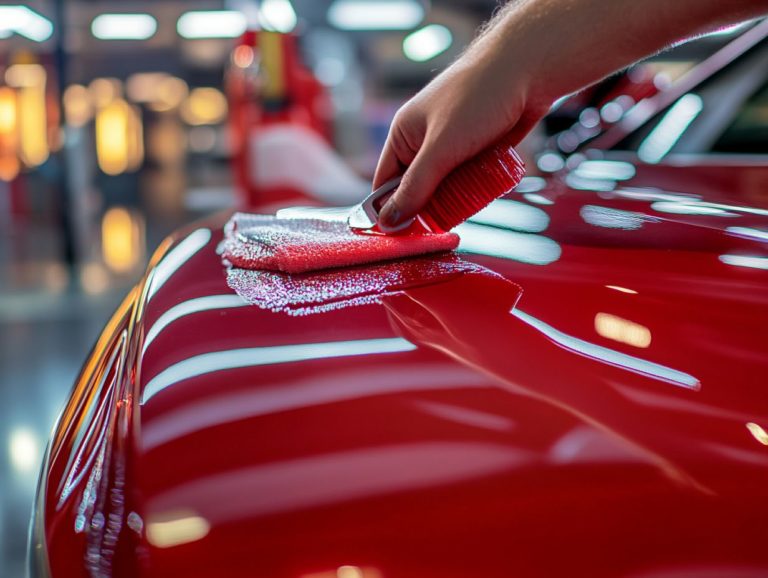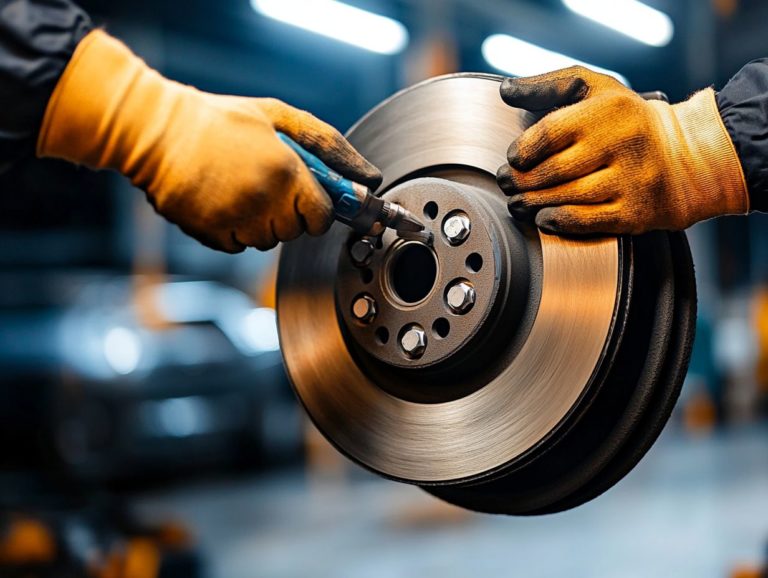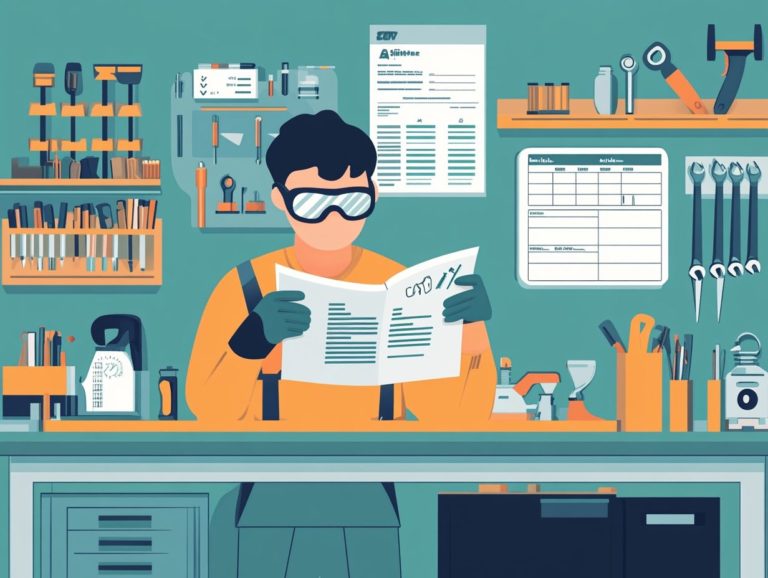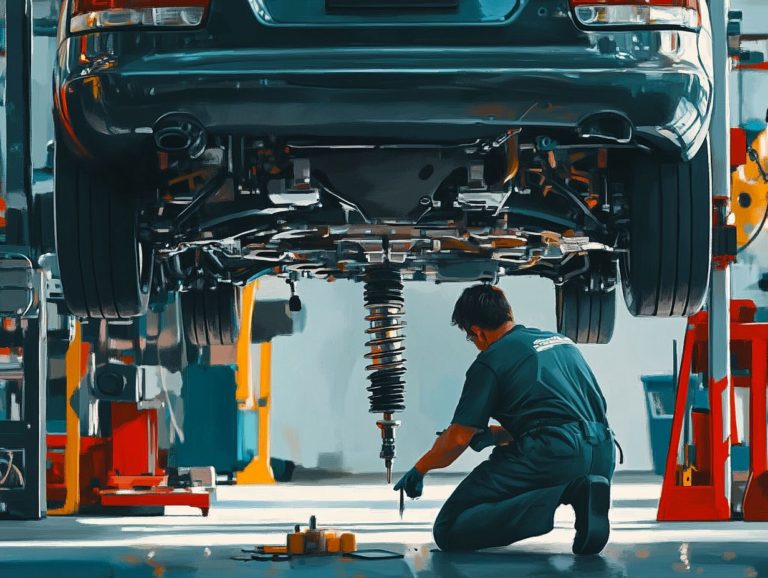Essential Tools for DIY Car Maintenance
Get ready to take charge of your car maintenance! If you’re aiming to take charge of your car s maintenance, having the right tools is crucial. This guide outlines the must-have hand tools and equipment that every DIY mechanic should possess, ranging from jack stands to oil filter wrenches. Don’t wait until it’s too late; start maintaining your vehicle today!
You ll uncover the advantages of handling car maintenance on your own, explore common tasks that are well within your capabilities at home, and gather invaluable safety tips to keep you secure along the way.
We will also highlight common mistakes to avoid, ensuring that your DIY journey is as rewarding as it is safe.
Dive in and discover how you can enhance your self-sufficiency with your vehicle!
Contents
- Key Takeaways:
- 1. Basic Hand Tools
- 2. Jack and Jack Stands
- 3. Oil Filter Wrench
- 4. Spark Plug Socket and Wrench
- 5. Oil Drain Pan
- 6. Funnel
- 7. Tire Pressure Gauge
- 8. Jumper Cables
- 9. Flashlight
- 10. Pliers
- 11. Screwdrivers
- 12. Adjustable Wrench
- 13. Torque Wrench
- 14. Car Manual
- 15. First-Aid Kit
- What Are the Benefits of DIY Car Maintenance?
- Frequently Asked Questions
- What must-have tools do you need for DIY car maintenance?
- Do I need specialized tools for DIY car maintenance?
- Where can I purchase the essential tools for DIY car maintenance?
- Can I save money by doing my own car maintenance?
- Do I need to have prior experience or knowledge to use these tools for DIY car maintenance?
- Are there any safety precautions I should take when using these tools for DIY car maintenance?
Key Takeaways:
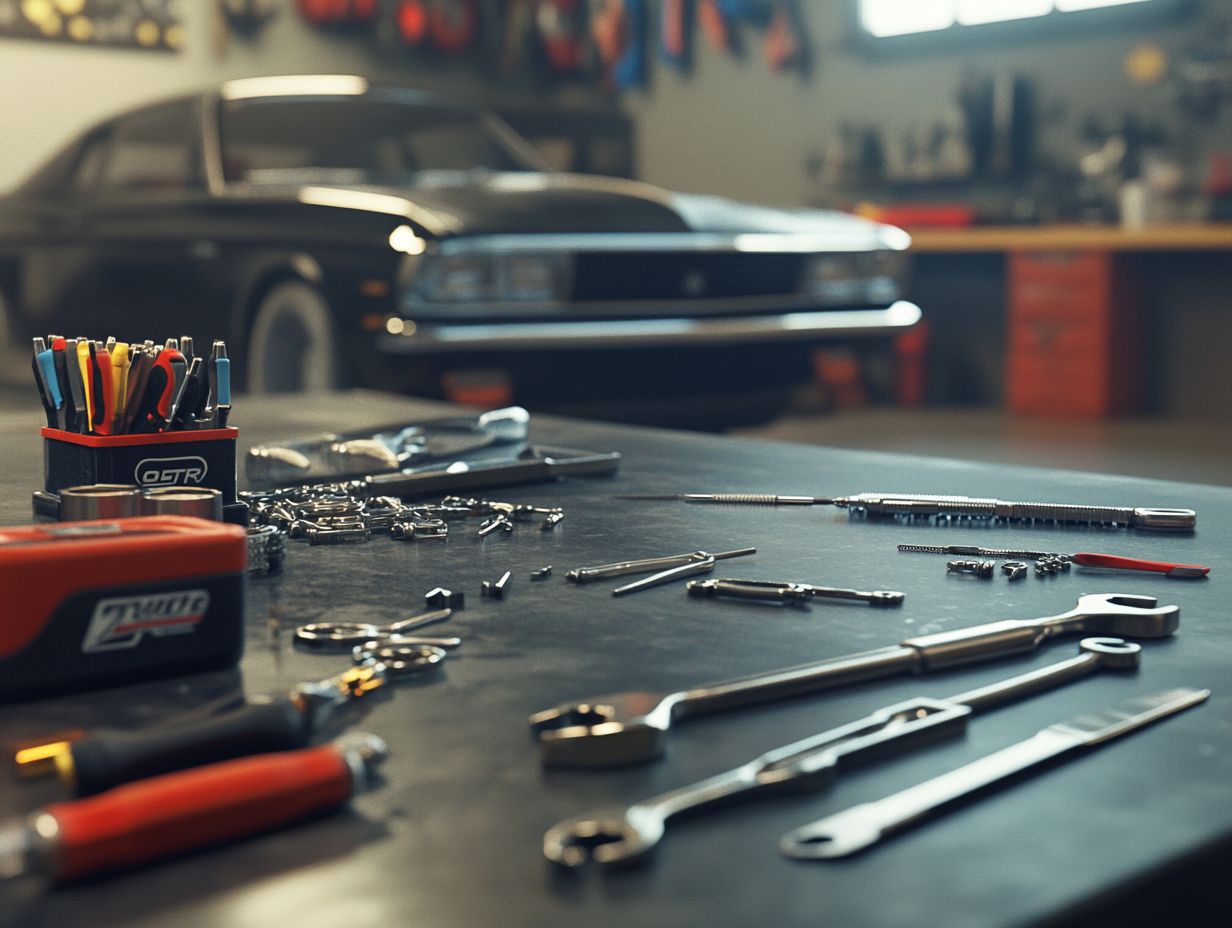
- Invest in basic hand tools to be prepared for simple car maintenance tasks.
- Having a jack and jack stands will help safely lift and support the car during maintenance.
- Don’t forget an oil filter wrench for easy removal and installation of the oil filter during an oil change.
1. Basic Hand Tools
When you embark on vehicle maintenance, having a well-equipped set of basic tools for car maintenance filled with essential hand tools is crucial. This is true whether you re a car enthusiast or a dedicated DIYer. Tools like pliers, wire cutters, a comprehensive screwdriver set, and combination wrenches create a solid foundation for efficient automotive care.
Items such as socket sets, hammers, and adjustable wrenches play important roles in tackling common repairs, whether you’re changing a tire or tightening loose components. When selecting the right tools, consider quality, durability, and ergonomics this refers to the design of the tools to ensure comfort and effectiveness during your work.
A well-organized toolbox not only saves you precious time but also minimizes frustration. Using tool trays or drawer dividers can help categorize your tools by type or size, making them easily accessible when you need them. By prioritizing organization, you can transform vehicle maintenance into a more enjoyable and productive experience.
2. Jack and Jack Stands
Jack and jack stands are very important for safe vehicle maintenance, enabling you to perform undercar inspections, tire changes, and other vital repairs with utmost confidence and security.
With a variety of options at your disposal hydraulic jacks, scissor jacks, and floor jacks selecting the right one hinges on the specific needs of your vehicle and the nature of the work you’re undertaking. Hydraulic jacks provide a smooth lifting experience and boast greater weight capacity, making them ideal for heavier vehicles. On the other hand, scissor jacks are typically more portable, offering a practical solution for emergencies.
Whichever type you choose, it s vital to pair them with sturdy jack stands to avert any potential accidents during maintenance. Properly positioning the jack stands not only enhances safety but also ensures your vehicle remains stable while you get to work underneath.
3. Oil Filter Wrench
An oil filter wrench is an essential addition to your DIY car maintenance toolkit, crafted specifically for the effortless removal and installation of oil filters. This tool ensures your vehicle runs at its best.
You’ll find these wrenches in a variety of types, including strap, band, and cap styles, each designed for different filter shapes and sizes. For example, strap wrenches excel with standard filters, while cap wrenches are perfect for those tight spots. Knowing which type to use can significantly streamline your maintenance process.
It’s important to handle these wrenches with care; applying excessive pressure may damage the filter or surrounding components. Always make sure your hands are clean and dry when using the tool, and consider adding a bit of oil to the wrench s surface to enhance your grip and prevent any unwanted slips.
Let s get started on making your car maintenance journey effective and enjoyable!
4. Spark Plug Socket and Wrench
A spark plug socket and wrench are essential tools for performing routine maintenance on your vehicle. They enable you to efficiently replace spark plugs, ensuring your engine operates at peak performance.
Understanding the importance of these tools goes beyond merely possessing them. It s about enhancing the overall reliability and efficiency of your vehicle.
Regularly changing spark plugs is crucial for maintaining your engine s power efficiency, optimizing fuel consumption, and ensuring a smooth combustion process. All of these contribute to prolonging your vehicle’s life.
When choosing a spark plug socket, ensure it aligns with the size of the spark plugs in your vehicle. A deep socket is often ideal for reaching those plugs that are nestled deep within the engine. Combine this with a suitable ratchet or wrench, and you’ll be well-equipped for the task at hand.
To replace the spark plugs, follow these steps:
- Disconnect the battery.
- Remove any obstructions to access the plugs.
- Unscrew the old plugs.
- Inspect them for wear.
- Finally, install the new plugs, following the tightening instructions.
This maintenance routine boosts your vehicle s performance and helps you avoid more significant and costly repairs down the road. Don’t wait too long to change your spark plugs; your engine’s performance depends on it!
5. Oil Drain Pan
An oil drain pan is an essential tool in your maintenance arsenal, enabling you to collect used oil safely and efficiently during oil changes while promoting environmental responsibility.
These pans come in various designs, both rigid and flexible, each tailored to meet your specific needs. Rigid models typically accommodate between 5 to 16 quarts, while flexible options often crafted from rubber or plastic can handle larger quantities, making them perfect for those bigger jobs.
In terms of disposal, it s crucial for you to adhere to local regulations regarding the recycling of used oil, as improper disposal can have detrimental effects on the environment.
Keep your workspace clean to stay safe and make your tasks easier and more enjoyable! By staying organized during your oil maintenance tasks, you can significantly minimize spills, transforming the entire experience into a more manageable and enjoyable endeavor.
6. Funnel
A funnel is an essential tool for you, the DIY car maintenance enthusiast, allowing you to pour fluids like oil and coolant with precision, eliminating spills and mess during your automotive repairs.
You ll find various types of funnels designed to meet different needs: from wide-mouthed versions perfect for oil changes to specialized designs that make transferring liquids into smaller openings a breeze. Each type has its purpose; for example, a flexible funnel easily navigates tight spaces, while a spout funnel is ideal for adding fluids to those hard-to-reach areas.
When choosing the right funnel, consider the viscosity of the fluid you re working with. A larger diameter is typically better for thicker oils, while smaller, narrower funnels excel at precision tasks like adding coolant or brake fluid.
Selecting a funnel crafted from durable, chemical-resistant materials can enhance its longevity and reliability, ensuring it’s a trusty companion in your automotive endeavors.
7. Tire Pressure Gauge
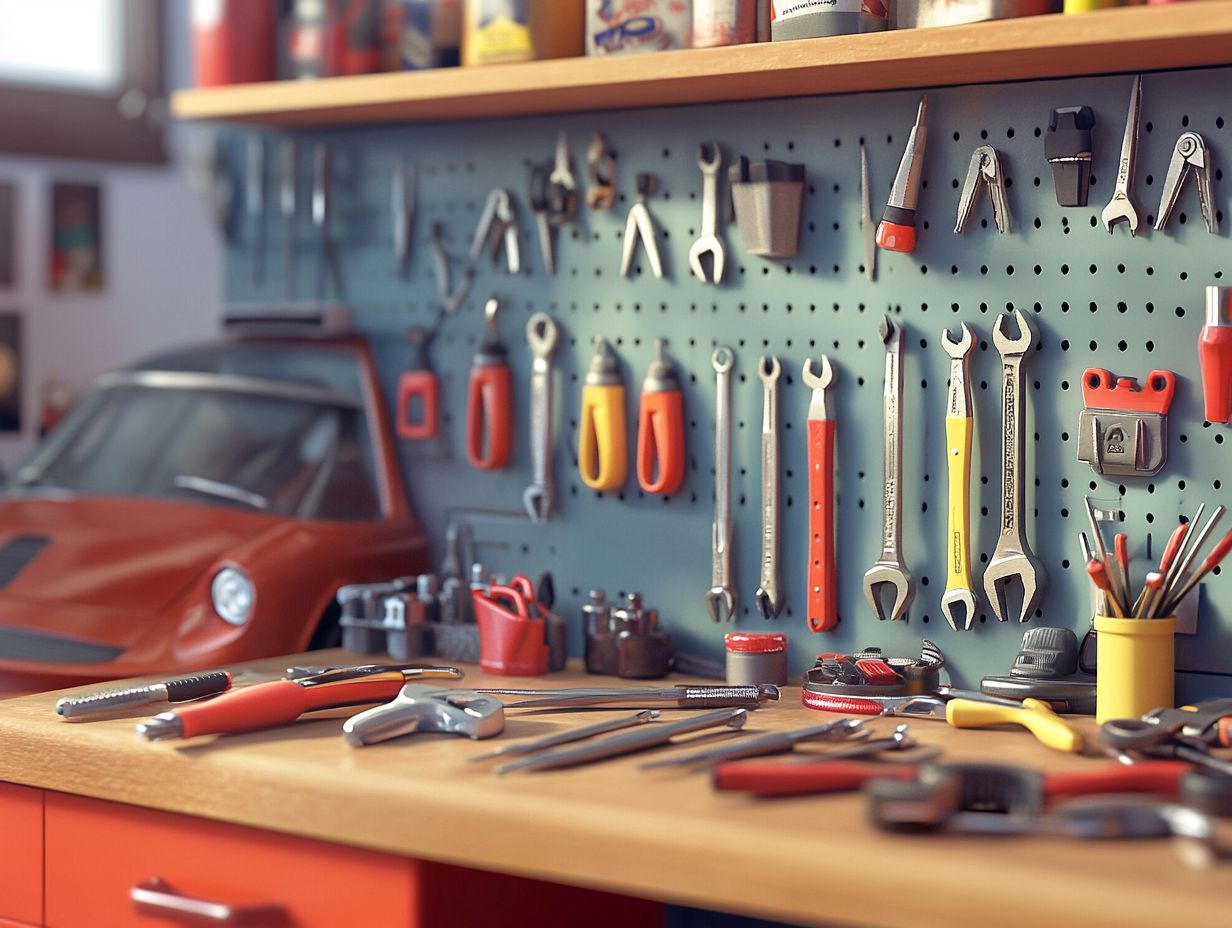
A tire pressure gauge is an essential tool for any discerning car enthusiast, enabling you to monitor and maintain optimal tire pressure essential for both vehicle safety and performance.
Proper tire inflation not only enhances traction and handling but significantly extends the life of your tires. To use a tire pressure gauge effectively, start by removing the valve stem cap, then press the gauge firmly onto the valve stem to obtain a reading.
It’s crucial to compare this measurement against the recommended pressure listed on your vehicle’s door jamb or in the owner’s manual. Maintaining the correct tire pressure not only improves fuel efficiency since under-inflated tires increase rolling resistance and demand more power and fuel but also contributes to safer driving.
By ensuring your tires are properly inflated, you reduce the risk of blowouts and enhance overall stability during maneuvers. Don’t underestimate the importance of regularly checking your tire pressure; it s vital for your safety!
8. Jumper Cables
Jumper cables are an essential addition to your DIY car maintenance toolkit. They offer a reliable solution for jump-starting vehicles and ensure you won’t find yourself stranded due to a dead battery.
These essential tools let you tap into the energy of another vehicle’s battery for a quick restart. It’s crucial to know the proper procedure and follow necessary safety precautions.
- Start by connecting the red cable to the positive terminal of the dead battery first, then link the other end to the positive terminal of the working battery.
- Connect the black cable to the negative terminal of the live battery. Then, attach the other end to a grounded metal surface on the dead vehicle.
Choosing the right cables is essential. Thicker cables provide better power for a faster jump. Don t forget to wear gloves and goggles for safety while you work!
9. Flashlight
A reliable flashlight or work light is a must-have for any car enthusiast. It brightens dark engine bays and those tricky nooks while you tackle vehicle maintenance, enhancing both safety and efficiency.
Choose the right flashlight type for your needs LED, tactical, or rechargeable. Each has its unique advantages. Brightness levels, measured in lumens, are crucial; higher ratings deliver a more powerful beam that cuts through darkness. Long battery life is also critical, as it means uninterrupted work during repairs.
Opt for a flashlight with adjustable settings, allowing you to tailor the brightness for different tasks. Effective use also involves strategic positioning of the flashlight to illuminate hard-to-reach spots while keeping your hands free.
10. Pliers
Pliers, particularly wirecutters, are essential hand tools for every DIY car enthusiast. They help you tackle various tasks, from gripping and twisting to cutting wires and components during automotive repairs.
Beyond wirecutters, you can find several types of pliers, such as needle-nose, slip-joint, and locking pliers. Each is designed for specific functions, making your maintenance tasks easier. For example, needle-nose pliers excel at reaching tight spaces, while slip-joint pliers offer adjustable jaws for gripping larger parts.
Pick the right pliers for your task. It will make your work easier. Consider the material you are working on and the space available. By selecting high-quality tools and understanding their unique strengths, you can enhance both your efficiency and effectiveness in maintaining your vehicle.
11. Screwdrivers
A good screwdriver set is a must-have for your vehicle maintenance toolkit. It enables you to handle various tasks with ease and precision.
These tools come in an array of types, including flathead, Phillips, Torx, and hex screwdrivers. Each is meticulously designed for specific fasteners throughout your vehicle. Flathead screwdrivers are ideal for slotted screws, while Phillips screwdrivers grip cross-headed fasteners well, especially in tight spots where maneuverability is key. Torx screwdrivers, with their star-shaped design, are popular in modern vehicles due to their security features that prevent tampering.
When choosing a screwdriver set, it s crucial to consider ergonomics and durability. A comfortable grip and hardened steel tips ensure these tools stand the test of time. Remember to maintain your tools with regular cleaning and proper storage, so they’re always in optimal condition and ready for your next repair task.
12. Adjustable Wrench
An adjustable wrench is a versatile tool. It’s essential for vehicle maintenance.
It enables you to tackle various nut and bolt sizes with remarkable ease, making it a must-have for any automotive repair enthusiast. Its clever design features a movable jaw, allowing for quick adjustments to fit different fasteners without the need to haul around an entire toolbox of wrenches.
This flexibility saves you valuable time and provides a practical solution when you’re working in tight spots.
Unlike fixed wrenches, which are confined to specific sizes, an adjustable wrench can efficiently accommodate a wider range of nuts and bolts. To ensure its longevity and protect your fasteners from damage, remember to use the wrench properly: position the jaws snugly around the fastener and avoid applying excessive force, as that could lead to stripping or rounding off edges.
13. Torque Wrench
A torque wrench is an essential precision tool for any DIY car maintenance enthusiast. It ensures that nuts and bolts are tightened precisely to the manufacturer’s specifications, preventing damage and enhancing safety.
When you utilize this tool effectively, you can significantly impact the longevity of your vehicle parts and the overall performance of your automobile. To set it correctly, familiarize yourself with the specifications in your vehicle’s service manual, adjusting the wrench to the tightness needed for nuts and bolts.
Regularly checking the accuracy of your tool and storing it properly helps maintain its effectiveness. By employing the correct technique applying consistent pressure and avoiding over-torquing you can further enhance your repairs. With these practices in mind, the torque wrench is your secret weapon for successful repairs!
14. Car Manual
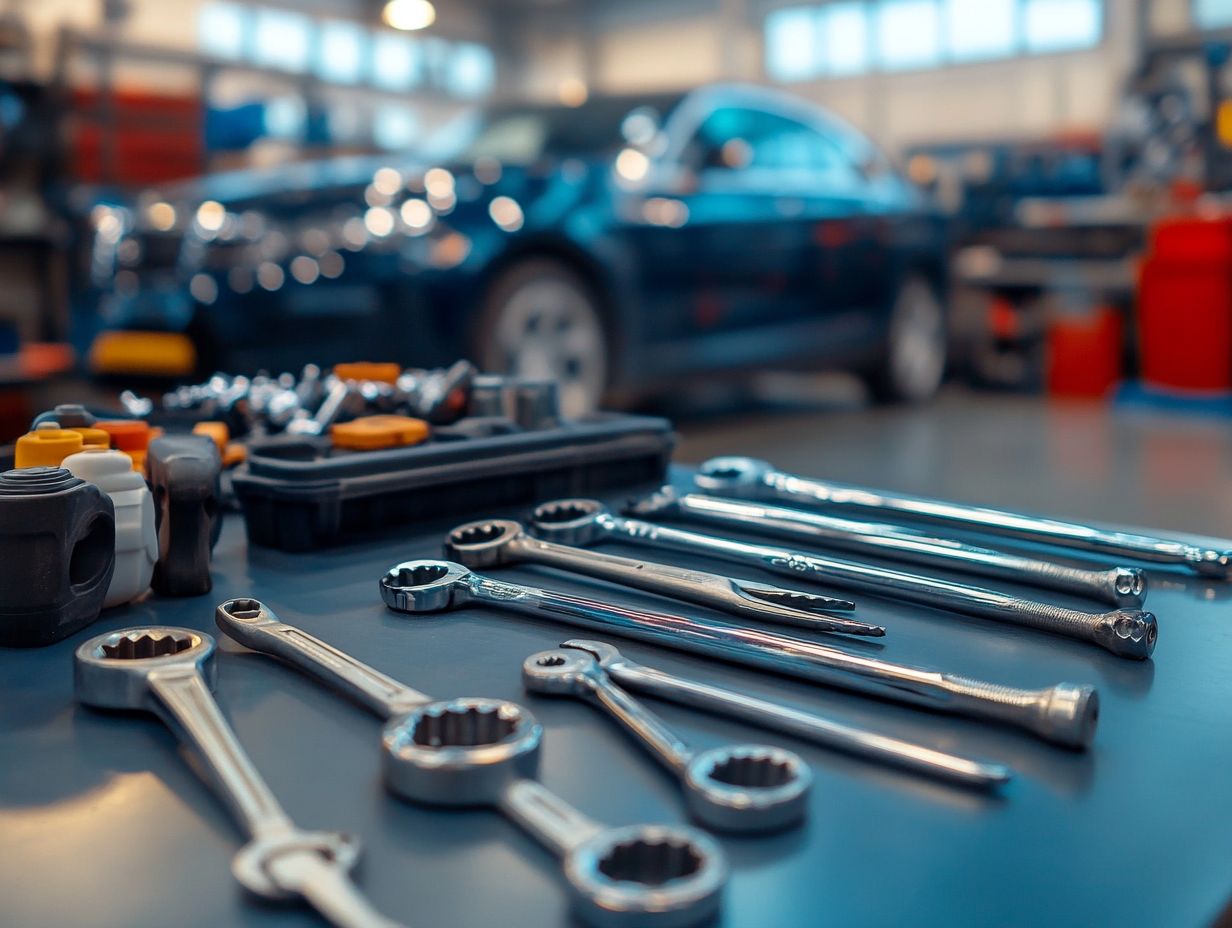
A factory service manual or repair manual is an essential resource for anyone engaged in vehicle maintenance. It offers vital insights into specifications, procedures, and troubleshooting for a variety of automotive issues.
This comprehensive guide serves as both an instructional tool and a reference to help you grasp the finer details of your specific vehicle model. To utilize it effectively, follow the outlined procedures step by step, ensuring that your repairs and maintenance are executed safely and accurately.
Familiarizing yourself with the troubleshooting section can be particularly advantageous when unexpected problems arise. Find reliable manuals on official manufacturer websites, dedicated forums, or reputable automotive bookstores, guaranteeing that the information is accurate and current for optimal results on the road.
15. First-Aid Kit
Having a well-stocked first-aid kit is essential for you as a dedicated DIY car maintenance enthusiast. It ensures you’re prepared for minor injuries while tackling automotive repairs, allowing you to prioritize your safety.
Make sure your kit includes these essential items:
- Adhesive bandages for pesky cuts
- Antiseptic wipes to clean up wounds
- Gauze pads to manage any bleeding
- Scissors for cutting tape or debris
- Tweezers for removing splinters
- Nitrile gloves for protection against infections
Don t wait check your supplies now! Knowing how to apply a bandage properly or when to use antiseptic can truly make a difference in managing minor incidents efficiently. Regularly check your supplies to ensure nothing is expired, and consider taking a basic first-aid course to sharpen your skills.
What Are the Benefits of DIY Car Maintenance?
DIY car maintenance saves money and helps you understand your vehicle better. It s not just about fixing things; it s about gaining valuable knowledge while enjoying the satisfaction of solving automotive issues yourself.
By taking on these tasks, you can significantly cut down on repair costs. This frees up funds to invest in upgrades for your vehicle or explore new hobbies. Many car enthusiasts share stories about how tackling simple maintenance jobs, like oil changes or brake replacements, has equipped them with new skills and instilled pride in their ability to keep their cars running smoothly.
There s something incredibly rewarding about diagnosing a problem and fixing it yourself. What might initially seem daunting can quickly turn into a gratifying experience that leaves you feeling accomplished and enabled.
What Are Some Common Car Maintenance Tasks That Can Be Done at Home?
Several car maintenance tasks are easy to tackle at home, especially if you’re a car enthusiast with the right tools. These tasks can greatly enhance your vehicle’s performance and lifespan.
- Regular oil changes are crucial. You ll need a wrench, an oil filter wrench (a tool that helps you remove the oil filter), and a drain pan to catch the used oil.
- Tire rotations ensure even wear; for this, a jack and a tire iron will be your best friends.
- Checking fluids like coolant, brake fluid, and windshield washer fluid is simple with dipsticks and containers for proper disposal.
Remember, working in a well-ventilated area and wearing gloves keeps you safe and makes the process more efficient. With these practices, you can maintain your vehicle with confidence and ease, making every DIY session a satisfying endeavor.
What Are Some Safety Precautions to Take When Doing DIY Car Maintenance?
When tackling DIY car maintenance, prioritizing safety is essential to prevent accidents and injuries. Create a secure working environment for your automotive endeavors.
First, wear latex gloves; they protect your skin from harmful substances and enhance your grip while handling tools. Using the right equipment like wrenches and screwdrivers designed for automotive tasks greatly reduces your risk of injury.
Make sure you re working in a well-ventilated area to minimize inhaling harmful fumes and vapors. Be aware of potential hazards like leaking fluids or faulty wiring. This awareness helps you tackle issues proactively, creating a safer workspace for all your car maintenance projects.
How Can a Beginner Get Started with DIY Car Maintenance?
For those stepping into DIY car maintenance, grasping the fundamentals of automotive care and assembling essential tools can set the stage for a rewarding experience.
Familiarize yourself with the common parts of a vehicle and their functions. Start gathering essential tools like a socket set, wrenches, and a jack these will become your best friends for various tasks. Initial tasks might include changing the oil, replacing air filters, or checking tire pressure these foundational skills are essential for every car owner.
Don t hesitate to use resources like online tutorials and automotive forums, which provide invaluable guidance and troubleshooting tips. As your confidence and skills grow, expanding your knowledge will enable you to tackle more complex repairs.
Soon, you’ll see car maintenance as a fun and rewarding adventure! Don’t wait any longer! Start your DIY journey today and discover the joy of car maintenance.
What Are Some Common Mistakes to Avoid When Doing DIY Car Maintenance?
When you dive into DIY car maintenance, steering clear of common mistakes is crucial for effective repairs and the longevity of your vehicle. This journey enhances your car’s performance and hones your valuable problem-solving skills.
Neglecting safety precautions can lead to injuries, so always wear the appropriate gear, like gloves and goggles. Another frequent misstep is using the wrong tools. Having the right equipment at your disposal prevents damage and ensures your repairs are executed flawlessly.
It might be tempting to skip steps to save time, but that often leads to more significant issues down the road. To avoid these pitfalls, take the time to read manuals, invest in quality tools, and follow a checklist for each repair project.
Be methodical and cautious to rapidly level up your DIY skills and feel the pride in your work!
Frequently Asked Questions
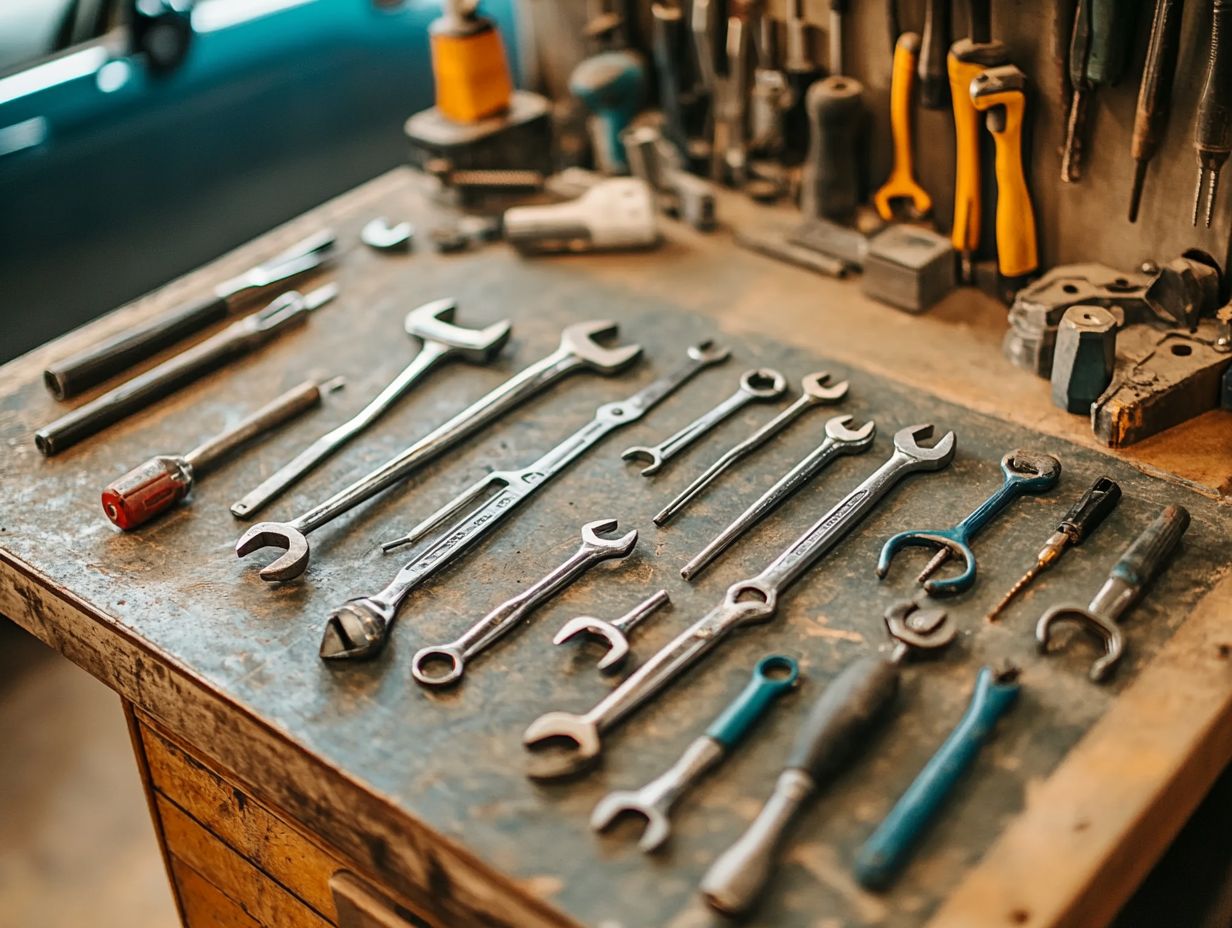
What must-have tools do you need for DIY car maintenance?
- Socket set
- Wrenches
- Screwdrivers
- Pliers
- Jack and jack stands
- Oil filter wrench
- Funnel
Do I need specialized tools for DIY car maintenance?
It is not necessary to have specialized tools for basic DIY car maintenance. Some specialized tools can make tasks easier, such as a code reader or a torque wrench.
Where can I purchase the essential tools for DIY car maintenance?
You can buy these tools at any auto parts store or online retailer. It’s a good idea to compare prices and read reviews before making a purchase.
Can I save money by doing my own car maintenance?
Yes, doing your own car maintenance can save you money in the long run. However, if you are not comfortable or confident in your abilities, it is best to leave more complex tasks to a professional to avoid causing further damage.
Do I need to have prior experience or knowledge to use these tools for DIY car maintenance?
Having some basic knowledge and experience with cars can be helpful, but many tools come with instructions. There are also online tutorials and videos available to guide you through various tasks.
Are there any safety precautions I should take when using these tools for DIY car maintenance?
Yes, it is important to always wear protective gear such as gloves and safety glasses when working on your car. It is also crucial to follow proper procedures and use caution when working with tools that can cause injury, such as jacks and power tools.
Start your hands-on experience today and transform your car maintenance routine!

